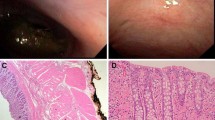Abstract
Background
Fundamental techniques and essential tools for performing “no scar” surgery still need to be developed. Our study was designed to evaluate the feasibility of performing small bowel resection by transcolonic NOTES® and transabdominal approach using rigid laparoscopic and flexible endoscopic instruments.
Methods
One non survival and four survival experiments were performed using a porcine model. The endoscope with an overtube was advanced into the peritoneal cavity through the colotomy. Mini-laparoscopic instruments were placed through the abdominal wall under the endoscopic observation. The endoscope was replaced with a rigid linear stapler. The small bowel was identified. The segment of the small bowel was resected by firing the endo stapler, and extracted through the colon. The two limbs of the small bowel were approximated with two stay-sutures. An enterotomy was then created on the antimesenteric sides of each line. A side-to-side anastomosis was performed with another application of the endo stapler. The stapler was withdrawn. The enterotomy was closed by suturing. The colotomy was closed with endoclips and the endoscope was withdrawn. The mini-laparoscopic instruments were removed.
Results
Small bowel resection was successfully performed in all animals. The surgery time was 70 minutes. There was no mortality or complications. The animals recovered uneventfully, and survived the 2 weeks postprocedure period. They remained healthy, and gained weight. Necropsy was performed 2 weeks after the surgery. On necropsy, evaluation of the abdominal skin revealed no scars. The peritoneal cavity was examined. No signs of infection, bleeding, perforations, and adhesions were noted. Endoscopic examination of the colotomy and anastomosis revealed complete healing that was confirmed by histopathology.
Conclusions
The study has demonstrated the feasibility of small bowel resection using transcolonic NOTES® and transabdominal approach. Simultaneous use of flexible endoscopic and rigid laparoscopic instruments in NOTES® is not only feasible but has significant advantages and greatly facilitates the performance of the operation, yet leaves no scars.



Similar content being viewed by others
References
Ryou M, Fong DG, Pai RD et al (2007) Dual-port distal pancreatectomy using a prototype endoscope and endoscopic stapler: a natural orifice transluminal endoscopic surgery (NOTES) survival study in a porcine model. Endoscopy 39:881
Isariyawongse JP, McGee MF, Rosen MJ et al (2008) Pure natural orifice transluminal endoscopic surgery (NOTES) nephrectomy using standard laparoscopic instruments in the porcine model. J Endourol 22:1087
Kantsevoy SV, Hu B, Jagannath SB et al (2006) Transgastric endoscopic splenectomy: is it possible? Surg Endosc 20:522
Merrifield BF, Wagh MS, Thompson CC (2006) Peroral transgastric organ resection: a feasibility study in pigs. Gastrointest Endosc 63:693–697
Stark M, Benhidjeb T (2007) Transcolonic endoscopic cholecystectomy: a NOTES survival study in a porcine model. Gastrointest Endosc 66:208–209
Pai RD, Fong DG, Bundga ME, Odze RD, Rattner DW, Thompson CC (2006) Transcolonic endoscopic cholecystectomy: a NOTES survival study in a porcine model. Gastrointest Endosc 64(3):428–434
Hagen ME, Wagner OJ, Swain PC, Patel A, Inan I, Pugin F, Fasel J, Morel P (2009) Transrectal natural orifice transluminal endoscopic surgery for umbilical hernia repair in a human cadaver (with video). Gastrointest Endosc 69(6):e53–e54
Voermans RP, van Berge Henegouwen MI, Bemelman WA, Fockens P (2009) Feasibility of transgastric and transcolonic natural orifice transluminal endoscopic surgery peritoneoscopy combined with intraperitoneal EUS. Gastrointest Endosc 69(7):e61–e67
Dubcenco E, Grantcharov T, Streutker CJ, Rotstein OD, Baxter NN, Jeejeebhoy KN, Baker JP (2008) The development of a novel intracolonic occlusion balloon for transcolonic natural orifice transluminal endoscopic surgery: description of the technique and early experience in a porcine model (with videos). Gastrointest Endosc 68(4):760–766
von Dellus S, Huber W, Feussner H, Wilhelm D, Karagianni A et al (2007) Effect of pneumoperitoneum on hemodynamics and inspiratory pressures during natural orifice transluminal endoscopic surgery (NOTES): an experimental, controlled study in an acute porcine model. Endoscopy 39:854–859
Kalloo AN, Singh VK, Jaggannath SB et al (2004) Flexible transgastric peritoneoscopy: a novel approach to diagnostic and therapeutic interventions in the peritoneal cavity. Gastrointest Endosc 60:114–117
Raju GS, Shibukawa G, Ahmed I et al (2007) Endoluminal suturing may overcome the limitations of clip closure of a gapping wide colon perforation (with videos). Gastrointest Endosc 65:906–911
Wilhelm D, Meining A, von Delius et al (2007) An innovative, safe and sterile sigmoid access (ISSA) for NOTES. Endoscopy 65:906–911
Kantsevoy SV, Hu B, Jagannath SB et al (2007) Technical feasibility of endoscopic gastric reduction: a pilot study in a porcine model. Gastrointest Endosc 65:510–513
Raju GS, Ahmed I, Xiao SY et al (2006) Controlled trial of immediate endoluminal closure of colon perforations in a porcine model by use of a novel clip device. Gastrointest Endosc 64:989–997
Fong DG, Pai RD, Thompson CC (2007) Transcolonic endoscopic abdominal exploration: a NOTES survival study in a porcine model. Gastrointest Endosc 65:312–318
Acknowledgments
The authors thank the American Society for Gastrointestinal Endoscopy and Pentax Medical Co. for providing training and video recording equipment; Olympus Canada Inc., Karl Storz Endoscopy Canada Ltd., AMT Endoscopy and Covidien for providing the study with free of charge endoscopic and laparoscopic equipment.
Disclosures
Drs. Dubcenco, Eng, Streutker, Baxter, Rotstein, and Baker have no conflicts of interest or financial ties to disclose. Dr. Grantcharov received research support grant from Covidien, Canada.
Author information
Authors and Affiliations
Corresponding author
Electronic supplementary material
Below is the link to the electronic supplementary material.
Video Clip “NO SCAR small bowel resection”. The video demonstrates our step-by-step technique for small bowel resection using transcolonic NOTES® and transabdominal approach. (MPG 70592 kb)
Rights and permissions
About this article
Cite this article
Dubcenco, E., Grantcharov, T., Eng, F.C.S. et al. “No scar” small bowel resection in a survival porcine model using transcolonic NOTES® and transabdominal approach. Surg Endosc 25, 930–934 (2011). https://doi.org/10.1007/s00464-010-1156-1
Received:
Accepted:
Published:
Issue Date:
DOI: https://doi.org/10.1007/s00464-010-1156-1




